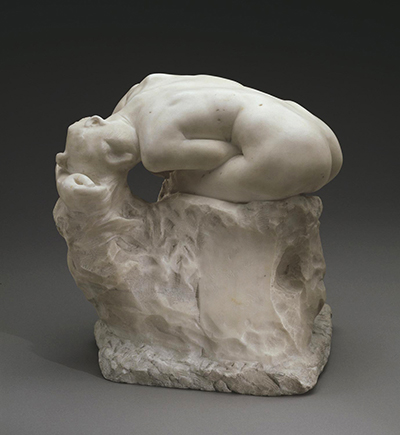In Greek mythology, Andromeda, the Ethiopian King's daughter, was said to be more beautiful than the attendants of Poseidon, the sea-god. Enraged, Poseidon threatened to destroy King Cephus's realm unless he gave up Andromeda for sacrifice. She was chained to a rock to be devoured by sea monsters. But Perseus, the son of Zeus, saved her.
Auguste Rodin (1840 - 1917) crafted four sculptures of Andromeda between 1885 and 1900. The 1886 version in this image has an unusual life story. In 1888, Rodin gave the sculpture as a gift to his friend and client, Carlos Morla Vicuna, a Chilean diplomat living in Paris. The gift remained in the family for over 130 years. Consequently, it was unknown in the art world until a chance discovery by Bruno Jaubert, a Director at Paris's Artcurial Auction House, during an inventory check in Spain. It went to auction in Paris on 30th May 2017. Estimated to go for approximately €1.2 million, it sold for almost €3.7 million to a private collector. It remains in a private collection.
Andromeda, though less well known than some of Rodin's other great works like The Thinker and The Kiss, is considered a masterpiece. Shaped in marble, Rodin chose this stone because Perseus was said to have thought Andromeda was made of marble when he first encountered her chained to the rock. As a student and follower of Albert-Ernest Carrier-Belluse (1824-1887), Rodin perfected his skills with clay, stone and marble. For him, Sculpture was a collaborative process. His Parisian studio was home to many talented plaster casters, founders and carvers who assisted in turning his clay designs into finished statues.
Rodin began with a drawing. He was known to draw his life models from different angles and heights. Often using a stepladder. He would then form a three-dimensional structure in clay, from which he would create a plaster-cast mould. He would sometimes use these same casts to create bronze versions of his marble sculptures. Although Rodin carved many of his marble sculptures himself, he also delegated some of the work to his students. He would supervise them, often marking points of the work-in-progress with pencil or chalk. Although Andromeda does not form part of Rodin's great achievement The Gates of Hell; its beauty and her near-tragedy would have made her a suitable addition.




